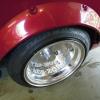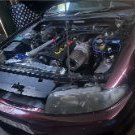Disadvantages Of Wolf 3d Ecu's?
Announcements
-
Similar Content
-
Latest Posts
-
Update for the sake of closure Ended up getting the intercooler piping all sorted, new plugs and yellow jacket coils, and she was idling mint until it warmed up while I was bleeding the cooling system. Found the misfire to be localised to cyl 3 by unplugging coilpacks, ran a compression test, that checked out, then decided to get a mate to check if that spark plug was firing out of the motor. Upon cranking it over, with the injectors disconnected, the car actually fired and ran on a couple cylinders and heaps of fuel came out the top of cyl 3 I'd say that injector's either spraying incorrectly or spraying far too much, which is fine as I'm planning on replacing them anyway I'm planning on making about 250kW on flex fuel, and have a set of 1000cc injectors from ozautosport, obviously overkill but I'm planning on building the motor and running more boost further down the line, do you reckon they'd be too big for a smooth idle on 98? Thanks for the replies gents, much appreciated
-
By Dose Pipe Sutututu · Posted
Nice modern Hypergear high flow would be perfect. -
By Murray_Calavera · Posted
I'm confused. You said you want to "remove the clear coat from most panels" but it sounds like you are actually doing a full respray? Few random things to add - If you chase the blistered paint with 120 grit, I can almost guarantee you'll chase it down to bare metal (that's fine). But if you paint the car from here, you'll have nice little indents where ever the blistered paint was. The new paint won't magically level out the low areas, you need to fill them. Which leads me to the main point I wanted to add, make sure the whole car is flat before you paint it. All those areas with blistered paint you sanded out, make sure to fill them and triple check they are flat with a block guide coat. I'd also check the whole car is flat with a large block and guide coat but yeah up to you if you want to go that far. -
300hp (225kw) is barely outside the standard turbo's range with a bit of extra boost in it (200ish). If you are going to change the turbo you should aim for 250-300kw (330-400hp) to make the expense worthwhile
-
By Murray_Calavera · Posted
A couple of things, firstly omg that turbo is expensive! $3,000 USD for dinosaur technology is robbery. You could buy a G series turbo and have a good amount of change instead. If you want a good budget option, have a look here - https://hypergearturbos.com/product/rb25dethighflow/ If you are keen to spend more, have look at the modern turbos, Garrett G series, Borgwarner EFR, etc. Have a look at the RB25 dyno results thread for inspiration. If you upgrade your turbo to something that will support the 300hp you want and only "probably" have Haltech ECU, your car will only "probably" run. Actually, no it won't run. You are going to need the ECU and injectors at the time you do the turbo upgrade. No thoughts on "this much boost" as you didn't say how much boost that actually is. Having said that, plenty of unopened RB25's making even more power then what you are chasing.
-







Recommended Posts
Create an account or sign in to comment
You need to be a member in order to leave a comment
Create an account
Sign up for a new account in our community. It's easy!
Register a new accountSign in
Already have an account? Sign in here.
Sign In Now